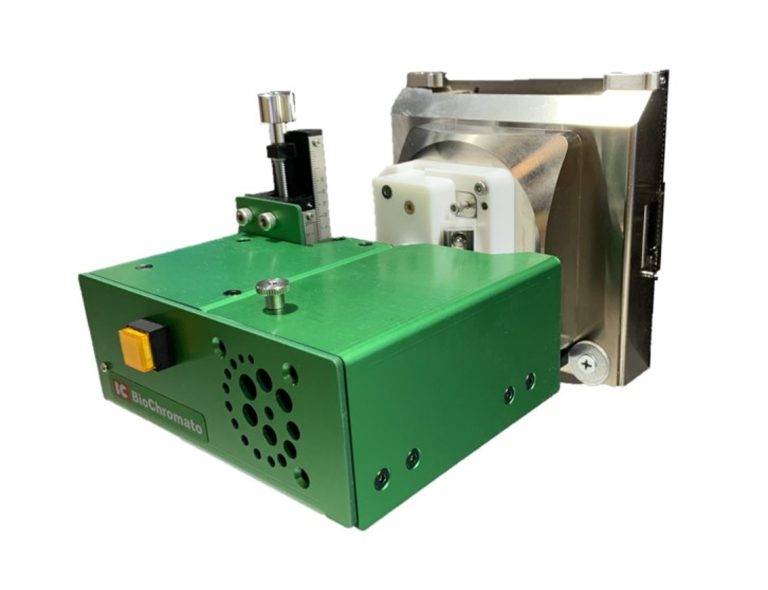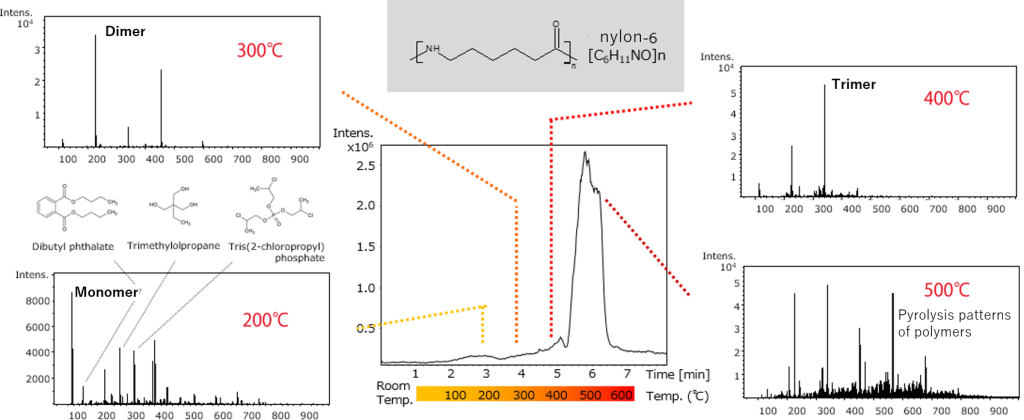Material Analysis System with ChemZo

New material analysis system that combines our proprietary ChemZo ion source for mass spectrometry with a heating device for direct measurement.
The heating device combined with ChemZo (the Ion Source for Mass Spectrometry) can heat the sample from room temperature to 600°C. Components vaporized by thermal desorption or pyrolysis are ionized by ChemZo and each ion is detected by QTOF. This allows direct analysis of a wide variety of materials.
Comparison with Other Methods (Pyrolysis GC/MS)
The ChemZo's heating mechanism eliminates the need for column separation, and allows ChemZo to perform the pyrolysis process from thermal desorption to pyrolysis in GC/MS analysis in just 7 minutes (temperature increase rate: 100°C/min, with the first 1 minute held at room temperature).
Faster Analysis Time
The so-called double-shot method, in which a thermal desorption method to analyze volatile components in polymers is followed by a pyrolysis method for residual polymers, takes about two hours. The ChemZo ion source for mass spectrometry, however, can perform the same measurement in just 7 minutes.
Wide Measurement Range
The pyrolysis GC/MS targets components of relatively low polarity and m/z less than 1000. ChemZo, on the other hand, targets components of low to high polarity and up to m/z 2000 or lower. In addition, unlike GC/MS, ChemZo does not have a separation column or cold spot, making it possible to detect components that, in principle, cannot be detected by GC/MS.
Ability to Identify Unknown Components
With pyrolysis GC/MS, it is very difficult to identify peaks that are not hit by the library because fragmentation occurs due to ionization by EI (Electron Ionization), making it difficult to detect molecular weight-related ions. On the other hand, the ChemZo ion source for mass spectrometry uses soft ionization, and molecular weight-related ions can be detected, making it possible to identify components even in unknown peaks by using a high-resolution MS such as TOF or Q-TOF type.
Materials Analysis using ChemZo Ion Source for Mass Spectrometry
Thermal Desorption and Pyrolysis (TDP)
- ChemZo's Ambient Ionization [45 sec].
What is ChemZo, an ion source for mass spectrometry that measures gases, liquids, and solids without preparation! [3:27 min].
Example of Thermal Desorption / Pyrolysis Direct Mass Spectrometry Measurement (nylon-6)
- Room temperature to 400°C: Thermal desorption range
Additives, residual monomers, etc., are detected according to boiling point order.
- 400-600°C: Pyrolysis range
Pyrolysis products of nylon-6 are detected.

The above is measured with the temperature increase rate set at 100°C/min. In the ChemZo's solids measurement mode (temperature gradient system), the temperature increase rate can be changed in the range of 50°C/min to 200°C/min.
Integrated Analysis Software
Spectra Scope
The integrated analysis software, Spectra Scope, comprises three specialized tools designed for advanced data analysis:
- Compound Search: A comprehensive material database for efficient compound identification.
- Polymer Engine: A powerful tool for Kendrick Mass Defect (KMD) analysis of pyrolyzed polymers.
- IDS (Intelligent Data Subtraction): A sophisticated software for detecting and analyzing differences between two samples.
🟩 Material database- Compound Search - |
| The database contains data on about 2,000 ingredients (e.g., additives, antioxidants, ultraviolet absorbers, flame retardants, hardening agent, cross-linkers, colorants, lubricants, monomers, etc.) for the chemical industry (ingredient names, chemical formulas, CAS No, m/z, Chemspider ID, and applications). Regardless of the type of mass spectrometer, any data can be searched by adjusting the m/z tolerance. You can also perform a batch search by converting the m/z values you wish to search for to a CSV or txt file. Adduct ions can also be searched by adding the desired ion species to the list. |
🟩 Polymer analysis (including KMD analysis)- Polymer Engine - |
| KMD (Kendrick Mass Defect) is a software that performs KMD (Kendrick Mass Defect) analysis. More than 30 types of “Repeat Structure (Base Unit)” are registered, and you can also register additional arbitrary “Repeat Structure”. The KMD plot can be automatically generated by loading data from ionRocket, LC/MS, MALDI-TOF-MS, or pyolizer GC/MS and checking for the presence or absence of the above registered "repeat structures" or several selected "repeat structures". The plots can be converted to m/z, and you can also check which ions are in the spectrum. |
🟩 Differential Analysis IDS- Intelligent Data Subtraction - |
| This software compares the data of two groups of questions. It is not the absolute value of the intensity of the ions to be compared, but the ions with a large rate of change are searched for. In addition, by comparing the data of two different polymers obtained with ionRocket, it is also possible to find a single polymer with a significant difference. *Only Bruker's data format (.d) is supported. |
The unlikely material database
“Compound Search”
Spectra Scope's Polymer Engine
“Polymer Analysis Software”
Applications
Click here for analytical applications related to material analysis systems.
Publications
Kenzo Hiraoka , Haruo Shimada, Kazumasa Kinoshita, Stephanie Rankin-Turner, Satoshi Ninomiya
Analytical Biochemistry, Volume 676, 1 September 2023, 115249
